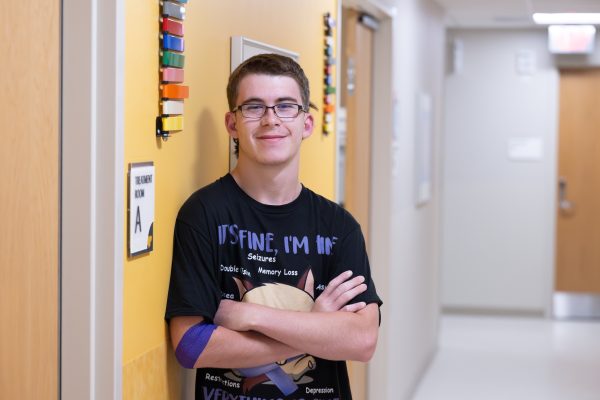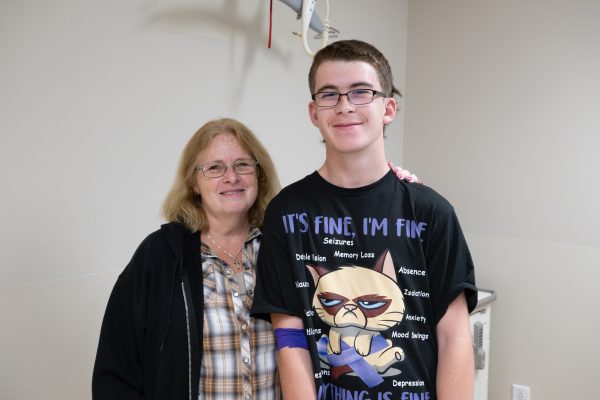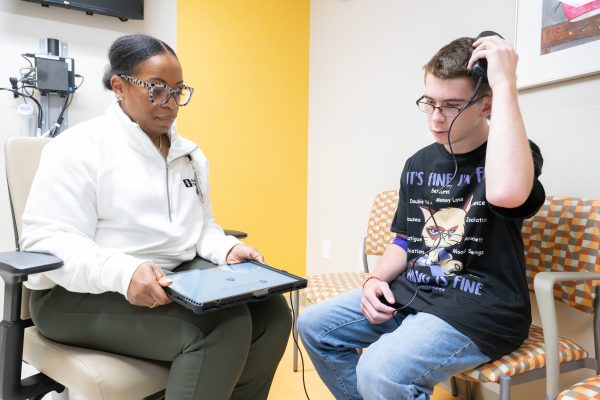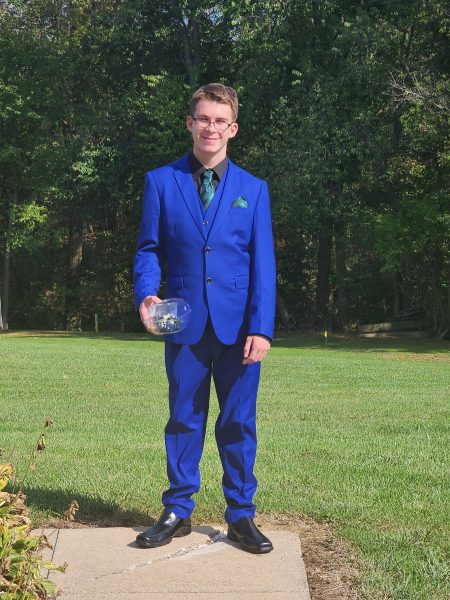
After suffering for years with seizures, the RNS has restored Conner’s confidence.
Conner Butler of Jeromesville, Ohio is a trailblazer. He’s the first Akron Children’s patient to have an RNS device implanted to reduce seizures caused by epilepsy. He’s gone from missing school and constantly worrying about seizures to being back in class and hanging out with his friends.
Diagnosis and daily struggles
As a child, Conner would “zone out.” Doctors thought it was a behavioral issue. “In August 2020, he had a full-body convulsion. A few months later, he had an episode of talking nonsense,” said his grandma and guardian, Michelle Bible. “On the way to the emergency room (ER), he had another convulsion and didn’t respond. We already had an appointment scheduled with Akron Children’s Neurology, but after the ER visit, we got in sooner.”
Conner, age 11 at the time, was diagnosed with epilepsy. This brain disorder causes seizures, which are surges of electrical activity in the brain and can affect how you appear or act. “At his worst, Conner had 4 to 5 seizures a week,” Michelle recalled. “When he had seizures, he would look off to the right and punch the air in front of him. He also wandered.”

Conner’s grandma, Michelle, is his biggest supporter.
Conner didn’t remember having a seizure, but he felt the effects for days afterward. “I felt tired, yucky and sick after each seizure,” he said. “I had headaches all the time, too.”
Michelle started to dread when her phone would ring. “I would send Conner to school, and they’d call me to come get him if he had a seizure,” she said. “I missed work, and it was stressful for all of us. Conner didn’t go to school for a year. The school arranged for a tutor to work with him at home 3 days a week.”
Exploring surgical options
When medications and dietary changes didn’t provide much relief, Pediatric Neurologist Dr. Chinasa Nwankwo shared surgical options. Resection is surgery to remove the part of the brain where seizure activity starts. A vagus nerve stimulation (VNS) device, implanted under the skin in the left chest wall, reduces the frequency and severity of seizures. An RNS, implanted in the skull, features two wires that target areas of the brain where seizures develop.
“I did a lot of research, comparing the RNS with the VNS and resection,” Michelle said. “Based on that research, I talked to Conner. He had the final say. We wanted a solution that gave him a chance at a ‘normal’ future. The RNS device was the best option.”

Dr. Nwankwo gets real-time data from Conner’s RNS and can make adjustments as needed.
How an RNS works
Pediatric Neurosurgeon Dr. Gwyneth Hughes performed the RNS surgery in August 2024. “RNS is a great device for patients like Conner with focal seizures, which come from the same area of the brain,” Dr. Nwankwo explained. “RNS doesn’t take any portion out of the brain like resection surgery. It’s reversible and will last the rest of his life, other than needing the battery replaced about every decade.”
The electrical stimulation part of the RNS wasn’t turned on for the first month, so the device could “learn” Conner’s brain activity. “We start low and work our way up, based on the data we receive from the RNS,” Dr. Nwankwo said. “When Conner has a seizure, he moves the RNS magnet over the implant. This marks the event and gives it extra emphasis in the daily download of data.”
RNS enables the neurology team to provide customized care for Conner. “Our goals were to reduce the number of seizures, get him back in school and reduce the daily medicine he takes,” Dr. Nwankwo said. “The longer the device is in there, the more it helps us improve Conner’s quality of life.”
Results are better and faster than expected
As the RNS learned Conner’s brain activity, his seizures started to decrease. In February 2025, he returned to school 4 days a week for 3 hours each day. In August, he returned to school full-time as a freshman at Hillsdale High School. “We expected it to take a year to see results, and he started to improve within 4 months,” Michelle said. “It’s been amazing.”
She credits Dr. Nwankwo for pointing them in the right direction toward RNS. “She listened to everything we said and answered every question,” Michelle said. “She’s phenomenal.”

Conner has sensitivity to strobing lights, so Hillsdale ensured the homecoming dance would be a safe environment for him.
Conner and Michelle today
Conner recently attended the Hillsdale homecoming dance. He works out with the football team and cheers them on every Friday from the sidelines. “He’s planning a vacation to Florida next summer, and he wants to go to Italy with his Future Farmers of America group in 2027,” Michelle said. “These trips weren’t feasible before the RNS.”
Since Conner’s trailblazing RNS surgery, 11 more Akron Children’s patients have received the device. “I’m happy to talk to families who are considering RNS and share how it’s changed our family’s life,” Michelle said. “Conner’s transformation has gone above and beyond what we hoped. I want that for other kids, too.”
Similar stories:
Learn more about our award-winning neurology care.

